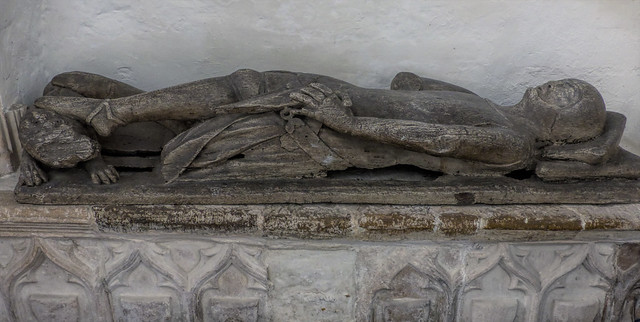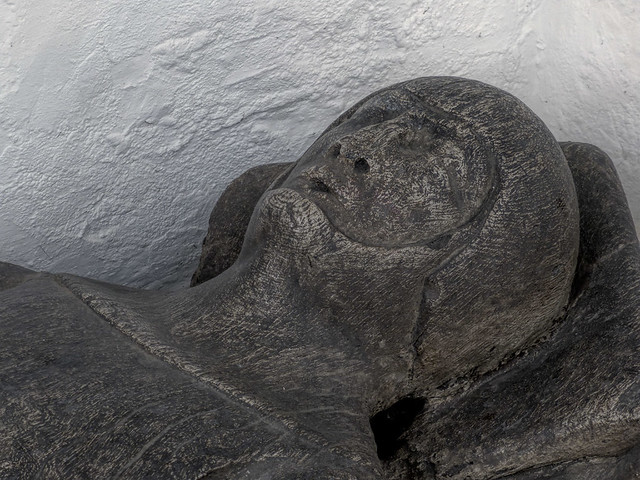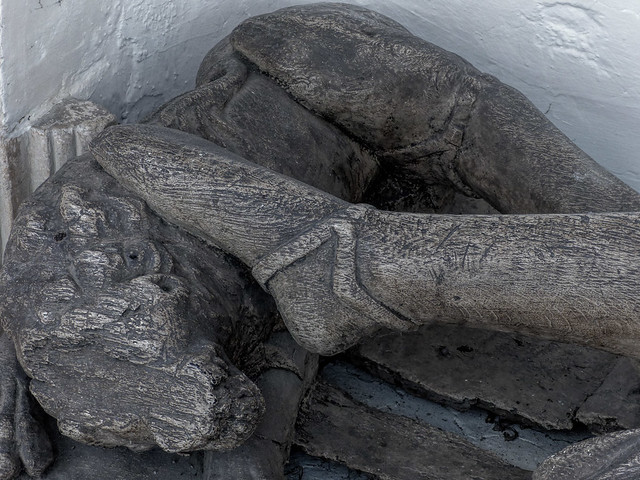Oak Cross-Legged Knight Effigy - Cold Higham, Northamptonshire

This striking medieval monument is a recumbent oak effigy of a cross-legged knight, dating to around 1350 and traditionally identified as Sir John de Pateshull (or Pattishull, d. c. 1349–1350), a local landowner and knight from the prominent Pateshull family who held the manor of nearby Pattishall. Carved from oak, a rarer, more durable wood choice for effigies compared to the prevalent alabaster or stone, this figure exemplifies East Midlands workshop craftsmanship, blending martial symbolism with devotional restraint. This is one of fewer than 100 surviving wooden knight figures in England,1 and transcends mere memorial: it immortalizes Sir John's legacy as a minor but dutiful baron, who was possibly involved in Edward III's French campaigns, within a church tied to his lineage since the 12th century. Its cross-legged stance invites reflection on medieval myths, once thought to signify Crusader status, now understood more as stylistic flair or familial tradition,2 while the oak's organic warmth humanizes the stone-cold Gothic ideal.
The effigy lies supine on a low, rectangular tomb chest of local stone, measuring about 6 feet in length, elevated slightly on a plinth within the church's modest chancel. The chest features ten ogee-headed (double-curved, Gothic) panels along its sides, each framed by cusped arches and containing worn heraldic shields, likely bearing the Pateshull arms (a chevron between three crescents), though erosion has obscured many details. The surrounding architecture, with its whitewashed walls, simple lancet windows, and 13th-century arcade, provides a serene, rustic frame, illuminated softly by natural light filtering through the east window. The oak's warm, golden patina, darkened by centuries of incense smoke and polish, contrasts vividly with the cooler stone environs, evoking a sense of intimate, woodland vitality.

Depicted in a classic cadaver-like repose, the slender, life-sized figure embodies the transitional military style of the mid-14th century, just as plate armor began supplanting chainmail. The knight's pose is emblematic: legs crossed at the knees in a gesture long romanticized (though now discounted) as denoting crusading zeal or martial prowess, with hands joined prayerfully over the chest in gauntleted grip, a universal motif of Christian supplication. His idealized, youthful face tilts slightly upward, eyes closed in eternal vigilance, conveying both repose and resolve.
The head rests on a plain pillow or tasselled cushion, crowned by a bascinet helmet with a slight aventail (mail neck guard) draping to the shoulders. A great sword, its pommel clasped between the hands, rises vertically from a scabbard at the waist, symbolizing justice and defense of the faith. Over a fitted jupon (padded tunic) emblazoned with heraldic quarterings, possibly Pateshull and allied families, lies a flowing surcoat, its folds carved with fluid, naturalistic drapery that catches the light, hinting at the knight's civilian grace beneath the warrior's shell.
The crossed legs, a hallmark of knightly effigies from c. 1250–1375, are elegantly elongated, with the right leg draped over the left at the knee, feet shod in pointed sabatons (armored boots) that terminate in subtle lion's paws, a common base motif for nobility, though here simplified without a full guardian beast. The overall slenderness emphasizes agility over bulk, reflective of the era's evolving jousting and battlefield tactics.
- 1.
English Church Monuments In The Middle Ages: History And Representation Oxford, New York 2009.p71.
- 2.
Of Armor And Men In Medieval England The Chivalric Rhetoric Of Three English Knights' Effigies Aldershot Ashgate 2004.p26.

